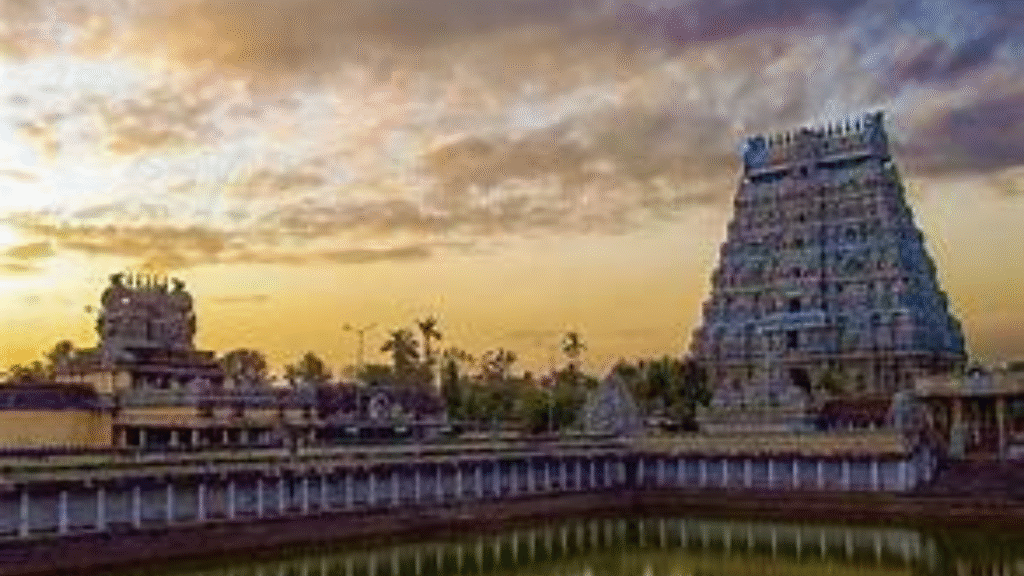Chidambaram Temple or Thillai Nataraja Temple, is one of the most iconic and spiritually significant temples in South India. Located in Chidambaram, a town in Tamil Nadu, the temple is dedicated to Lord Nataraja, a form of Lord Shiva depicted as the cosmic dancer. With a history that dates back more than a thousand years, the temple is revered not only for its religious importance but also for its architectural brilliance and cultural legacy.
| Temple Name | Chidambaram Nataraja Temple (Thillai Nataraja Temple) |
| Location | Chidambaram, Cuddalore District, Tamil Nadu, India |
| Primary Deity | Lord Nataraja (Shiva as the Cosmic Dancer) |
| Unique Feature | Chidambara Rahasyam – the formless representation of Shiva |
| Represented Element | Akasha (Space) – one of the Pancha Bhoota Stalas |
| Built By | Initially by Cholas (9th century CE), expanded by Pandyas & Vijayanagara |
| Architecture Style | Dravidian Architecture |
| Key Festivals | Margazhi Thiruvathirai, Aani Thirumanjanam, Natyanjali Festival |
| Specialty | Lord Shiva worshipped in anthropomorphic form |
| Ritual Priests | Dikshitars (hereditary Brahmin priests) |
| Temple Timings | 6:00 AM – 12:00 PM and 5:00 PM – 10:00 PM (Daily) |
| Nearest Airport | Puducherry Airport (~66 km), Chennai International Airport (~235 km) |
| Important Symbolism | Ananda Tandava – dance of creation, preservation, and destruction |
| Visitor Tips | Modest dress, no photos inside sanctum, guided tours recommended |
Location and Significance
Situated about 235 km from Chennai, Chidambaram Temple lies in the Cuddalore district of Tamil Nadu. It holds a central place in the Saivaite tradition and is one of the Pancha Bhoota Stalas, representing the element Akasha (space). The temple celebrates Lord Shiva in his dynamic form as Nataraja, performing the Ananda Tandava, or the Dance of Bliss.
The town’s name—Chidambaram—is derived from the Tamil words Chit (consciousness) and Ambaram (sky or atmosphere), symbolizing the “Sky of Consciousness”. This aligns with the temple’s core philosophy of divine presence in formlessness and space.
Historical Background
The original structure is believed to have been built by the Chola dynasty in the 9th century CE, although it underwent several renovations and expansions by later dynasties, including the Pandyas, Vijayanagara rulers, and the Marathas. The temple’s inscriptions, sculptures, and bronzes are precious records of Tamil religious and artistic heritage.
Chidambaram Temple is also historically important as one of the few temples in India where Lord Shiva is worshipped in anthropomorphic form rather than a lingam.
Temple Architecture
The Chidambaram Temple complex spans around 50 acres, showcasing Dravidian architecture in its most refined form. The temple features four massive gopurams (gateway towers), each richly decorated with intricate carvings of mythological stories, gods, and celestial dancers.
At the heart of the temple lies the Chit Sabha, the sanctum sanctorum where the Nataraja idol is housed. What makes this shrine unique is the presence of the Chidambara Rahasyam, the “Secret of Chidambaram”—a small curtain behind which is a space symbolizing the formless state of Shiva. When the curtain is drawn aside, it reveals golden bilva leaves representing the deity, suggesting that divinity transcends physical form.
The Ananda Tandava
Lord Shiva as Nataraja is shown dancing within a circle of fire, standing on the dwarf demon Apasmara, who symbolizes ignorance. The cosmic dance represents the cycles of creation, preservation, and destruction. Each gesture in the dance holds symbolic meaning—upliftment of devotees, destruction of evil, and the rhythm of the universe.
The bronze idol of Nataraja in Chidambaram Temple is globally celebrated as a masterpiece of Indian art and philosophy, even featured in institutions like CERN and NASA for its symbolic connection to cosmic motion and energy.
Festivals and Rituals
Chidambaram Temple is a hub of spiritual activity throughout the year. Among the most important festivals celebrated here are:
- Margazhi Thiruvathirai: Held in December–January, this is the most significant festival, marking the cosmic dance of Lord Nataraja.
- Aani Thirumanjanam: Celebrated in June–July, this festival involves ceremonial bathing of the deity.
- Natyanjali Festival: Held during Mahashivaratri, dancers from across the country gather to offer their art as a form of worship to Lord Nataraja.
The daily rituals at the temple are performed by Dikshitars, a group of Shaivite Brahmins who have been the traditional custodians of the temple for centuries.
Philosophical Importance
The Chidambaram Temple uniquely combines Shaivism, Vaishnavism, and Shaktism. Within the same complex, there are shrines dedicated to Govindaraja Perumal (Vishnu) and Goddess Sivakami (Parvati), portraying the temple’s inclusive spiritual approach.
The temple emphasizes the idea that God is both with form and formless, offering a holistic spiritual experience. The concept of Chidambara Rahasyam encourages seekers to understand the transcendental nature of the divine, pointing beyond rituals and idols to the realm of pure consciousness.
Getting There
Chidambaram is well-connected by road and rail. The nearest airport is Puducherry Airport (around 66 km away), followed by Chennai International Airport.
Regular buses and trains operate between Chidambaram and major cities like Chennai, Tiruchirappalli, and Madurai. The town also offers decent accommodation options, ranging from budget lodges to spiritual guest houses.
Timings
| Day | Morning | Evening |
|---|---|---|
| Monday–Sunday | 6:00 AM – 12:00 PM | 5:00 PM – 10:00 PM |
Note: Special poojas and abhishekams are conducted during festival days and on request.
Visitor Tips
- Dress modestly to respect temple customs.
- Photography is not allowed inside the sanctum.
- Footwear must be left at designated counters.
- Opt for a guided tour to fully appreciate the temple’s symbolism.



